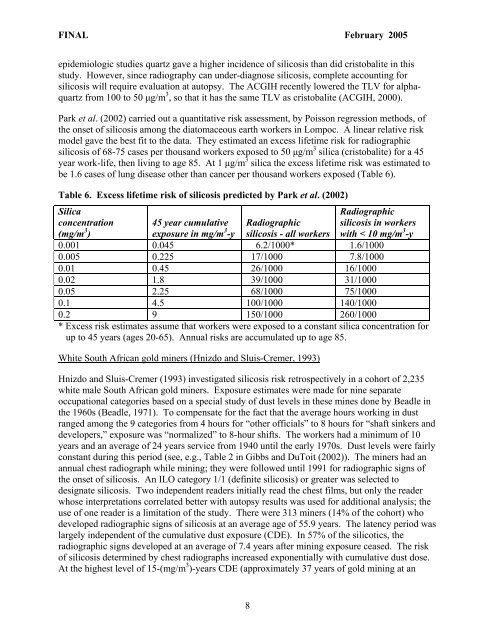Silica (crystalline, respirable) - OEHHA
Silica (crystalline, respirable) - OEHHA
Silica (crystalline, respirable) - OEHHA
Create successful ePaper yourself
Turn your PDF publications into a flip-book with our unique Google optimized e-Paper software.
FINAL February 2005<br />
epidemiologic studies quartz gave a higher incidence of silicosis than did cristobalite in this<br />
study. However, since radiography can under-diagnose silicosis, complete accounting for<br />
silicosis will require evaluation at autopsy. The ACGIH recently lowered the TLV for alphaquartz<br />
from 100 to 50 µg/m 3 , so that it has the same TLV as cristobalite (ACGIH, 2000).<br />
Park et al. (2002) carried out a quantitative risk assessment, by Poisson regression methods, of<br />
the onset of silicosis among the diatomaceous earth workers in Lompoc. A linear relative risk<br />
model gave the best fit to the data. They estimated an excess lifetime risk for radiographic<br />
silicosis of 68-75 cases per thousand workers exposed to 50 µg/m 3 silica (cristobalite) for a 45<br />
year work-life, then living to age 85. At 1 µg/m 3 silica the excess lifetime risk was estimated to<br />
be 1.6 cases of lung disease other than cancer per thousand workers exposed (Table 6).<br />
Table 6. Excess lifetime risk of silicosis predicted by Park et al. (2002)<br />
<strong>Silica</strong><br />
concentration<br />
Radiographic<br />
silicosis in workers<br />
with < 10 mg/m 3 -y<br />
(mg/m 3 45 year cumulative<br />
)<br />
exposure in mg/m 3 Radiographic<br />
-y silicosis - all workers<br />
0.001 0.045 6.2/1000* 1.6/1000<br />
0.005 0.225 17/1000 7.8/1000<br />
0.01 0.45 26/1000 16/1000<br />
0.02 1.8 39/1000 31/1000<br />
0.05 2.25 68/1000 75/1000<br />
0.1 4.5 100/1000 140/1000<br />
0.2 9 150/1000 260/1000<br />
* Excess risk estimates assume that workers were exposed to a constant silica concentration for<br />
up to 45 years (ages 20-65). Annual risks are accumulated up to age 85.<br />
White South African gold miners (Hnizdo and Sluis-Cremer, 1993)<br />
Hnizdo and Sluis-Cremer (1993) investigated silicosis risk retrospectively in a cohort of 2,235<br />
white male South African gold miners. Exposure estimates were made for nine separate<br />
occupational categories based on a special study of dust levels in these mines done by Beadle in<br />
the 1960s (Beadle, 1971). To compensate for the fact that the average hours working in dust<br />
ranged among the 9 categories from 4 hours for “other officials” to 8 hours for “shaft sinkers and<br />
developers,” exposure was “normalized” to 8-hour shifts. The workers had a minimum of 10<br />
years and an average of 24 years service from 1940 until the early 1970s. Dust levels were fairly<br />
constant during this period (see, e.g., Table 2 in Gibbs and DuToit (2002)). The miners had an<br />
annual chest radiograph while mining; they were followed until 1991 for radiographic signs of<br />
the onset of silicosis. An ILO category 1/1 (definite silicosis) or greater was selected to<br />
designate silicosis. Two independent readers initially read the chest films, but only the reader<br />
whose interpretations correlated better with autopsy results was used for additional analysis; the<br />
use of one reader is a limitation of the study. There were 313 miners (14% of the cohort) who<br />
developed radiographic signs of silicosis at an average age of 55.9 years. The latency period was<br />
largely independent of the cumulative dust exposure (CDE). In 57% of the silicotics, the<br />
radiographic signs developed at an average of 7.4 years after mining exposure ceased. The risk<br />
of silicosis determined by chest radiographs increased exponentially with cumulative dust dose.<br />
At the highest level of 15-(mg/m 3 )-years CDE (approximately 37 years of gold mining at an<br />
8















